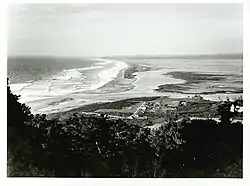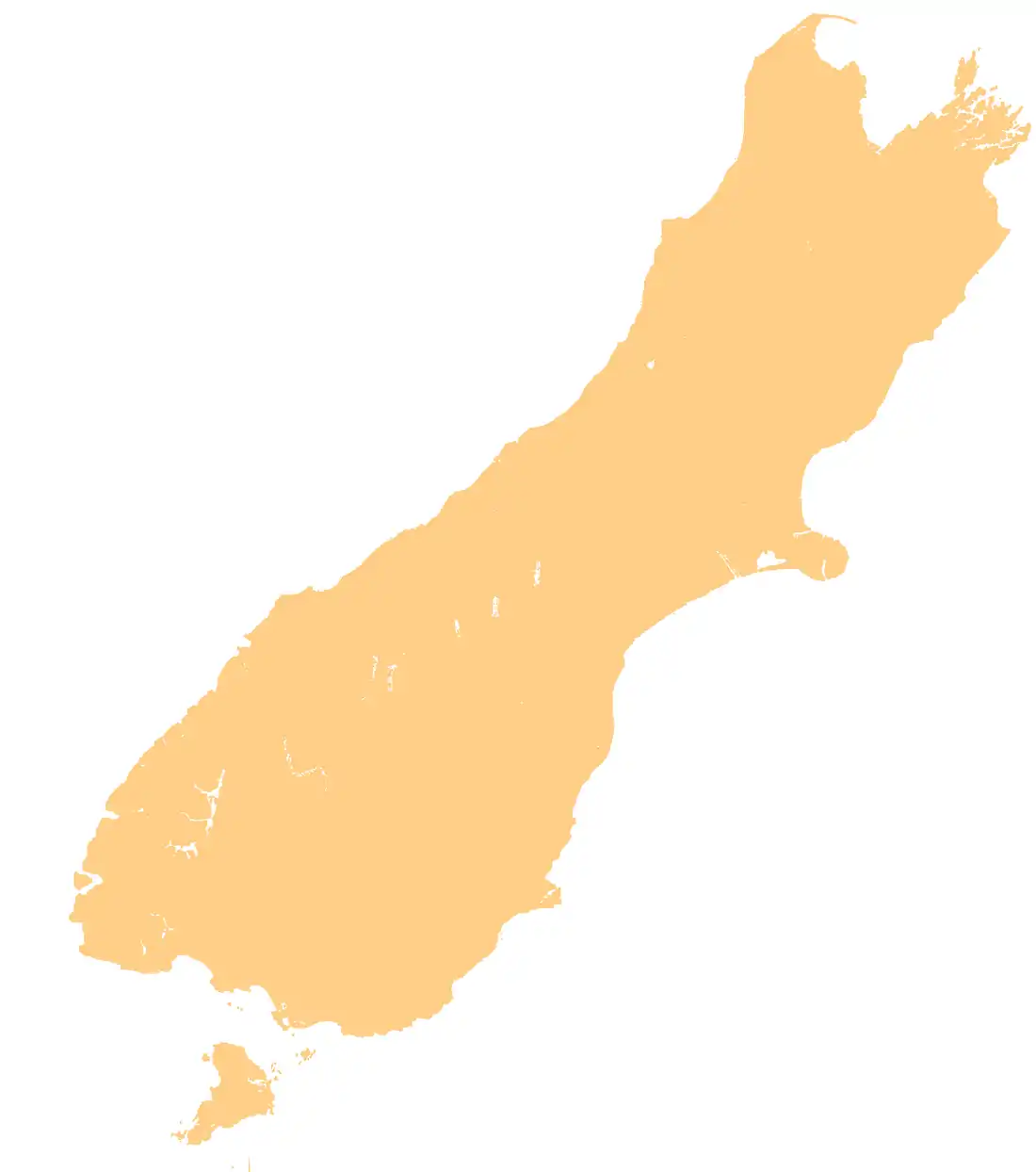Ōkārito | |
|---|---|
 Ōkārito and the lagoon in the early 20th century | |
 Ōkārito | |
| Coordinates: 43°12′S 170°13′E / 43.200°S 170.217°E | |
| Country | New Zealand |
| Region | West Coast |
| District | Westland District |
| Time zone | UTC+12 (NZST) |
| • Summer (DST) | UTC+13 (NZDT) |
| Postcode | 7886 |
| Area code | 03 |
| Local iwi | Ngāi Tahu |
_(14596979517).jpg.webp)
Ōkārito is a small coastal settlement on the West Coast of New Zealand's South Island, 127 kilometres (79 mi) southwest of Hokitika, and 10 kilometres (6.2 mi) from State Highway 6. It is built at the southern end of the Ōkārito Lagoon at the mouth of the Ōkārito River. The settlement of The Forks is located just inland, on the banks of the river.[1]
Name
Ōkārito's name is from the Māori Ō, place of, and kārito, the young shoots of the bulrush or raupō (Typha orientalis), a valued food source.[2] Another account has Ōkārito taking its name from a rangatira named Kārito, whose daughters Mapourika and Wahapako gave their names to nearby Lake Mapourika and Lake Wahapo. The settlement's official name has been spelled with macrons over the vowels since 2010, although it is still commonly seen written as "Okarito".[3]
History
Māori occupation and seasonal harvesting in area began over 600 years ago.[4]
The Ōkārito historic gold mining settlement is home to Donovan's Store, the oldest known building on the West Coast,[5][6] and the Ōkārito Memorial Obelisk, a heritage listed obelisk.[7][8] The obelisk commemorates the 1860 purchase of Westland from local Maori, as well as the date that Abel Tasman and James Cook sailed by, on 13 December 1642 and 23 March 1770 respectively.
Originally a gold mining township, the population reached over 1,500 in 1866.[9] It is now permanent home to only about 30 residents; among them the late Booker Prize-winning writer Keri Hulme and landscape photographer Andris Apse.
Bird watching, eco-tours and kayak tours of the lagoon are available, and there are a number of local walking tracks.
In 1909 the bones of a whale beached in 1908, 6 miles (9.7 km) north of the settlement were taken to Canterbury Museum and displayed and called the Okarito Whale.[10][11]
Wildlife
The rarest species of kiwi, the Okarito kiwi, or rowi, is found near the town of Ōkārito.[12][13]
The lagoon is one of the main feeding grounds for the White Heron during the spring and summer months, however the White Heron do not nest at Okarito.
Events
Since 2021, the Ōkārito GorseBusters initiative has attracted people from across the county to provide a helping hand clearing gorse and weeds in the area, with 90 volunteers in the first year and 116 during GorseBusters 2: 'The return of the pricks'.[14][15][16][17]
Since the start of GorseBusters, around 31km of shoreline has been cleared of gorse and 50,000 gorse plants have been treated.[14]
References
- ↑ GEOnet Names Server (GNS)
- ↑ Reed, A. W. (2016). Māori place names: their meanings and origins. Dowling, Peter (4th ed.). Auckland: Oratia Books. ISBN 978-0-947506-08-7. OCLC 953603373.
- ↑ "Ōkārito Lagoon". NZGB Gazetteer. Retrieved 7 October 2020.
- ↑ "Okarito". West Coast New Zealand History. Retrieved 24 September 2020.
- ↑ "Donovan's Store, Okarito, 1989". West Coast New Zealand History. Retrieved 24 September 2020.
- ↑ "Donovan's Store". www.doc.govt.nz. Retrieved 24 September 2020.
- ↑ "Search the List | Memorial Obelisk | Heritage New Zealand". www.heritage.org.nz. Retrieved 24 September 2020.
- ↑ "NZPlaces". nzplaces.nz. Retrieved 24 September 2020.
- ↑ "Okarito Travel Guide Whataroa White Herons Okarito Lagoon Tours West Coast New Zealand". Glaciercountry.co.nz. Retrieved 13 January 2015.
- ↑ "The Okarito Whale". The Queenslander. 22 May 1909. p. 40. Retrieved 24 November 2012 – via National Library of Australia.
- ↑ "A NOTABLE EXHIBIT". The Northern Star. Lismore, NSW. 29 October 1908. p. 2. Retrieved 24 November 2012 – via National Library of Australia.
- ↑ Robertson, H.A. (2017). "Okarito brown kiwi". New Zealand Birds Online. Retrieved 10 March 2020.
- ↑ Adams, R. (2017). "White heron". New Zealand Birds Online. Retrieved 10 March 2020.
- 1 2 Kilpatrick, Mike (21 June 2022). "Tourism businesses put in hard mahi for the environment while borders were closed". Newshub.
- ↑ "Ōkārito GorseBusters". RNZ. 8 July 2022.
- ↑ Bywater, Thomas (5 March 2022). "Gorse Busters: Okarito Kayaks' volunteer project attracts tourists". NZ Herald.
- ↑ Williams, Lois (10 April 2022). "Gorsebusters of Okarito lagoon". The Newsroom.
